How to Make Sourdough Starter From Scratch: Easy Step-by-Step Recipe
Have you been dreaming of fresh homemade sourdough bread, but aren’t sure where to begin? First, you need a sourdough starter! Then you can bake your own delicious gut-healthy bread, crackers, cookies, muffins and more.
Come follow our easy recipe to make a sourdough starter from scratch. This guide will show you how to transform three simple ingredients – water, flour, and apple – into an active and bubbly sourdough starter. The process takes 7 days from start-to-finish but involves very few steps or active time!
I’ve included everything you need to succeed: step-by-step photos, a video tutorial, troubleshooting tips, and resources on how to maintain and feed sourdough starter going forward. Don’t worry – it’s much easier than you think!
NOTE: This post was originally published in January 2019 and significantly updated in 2025.
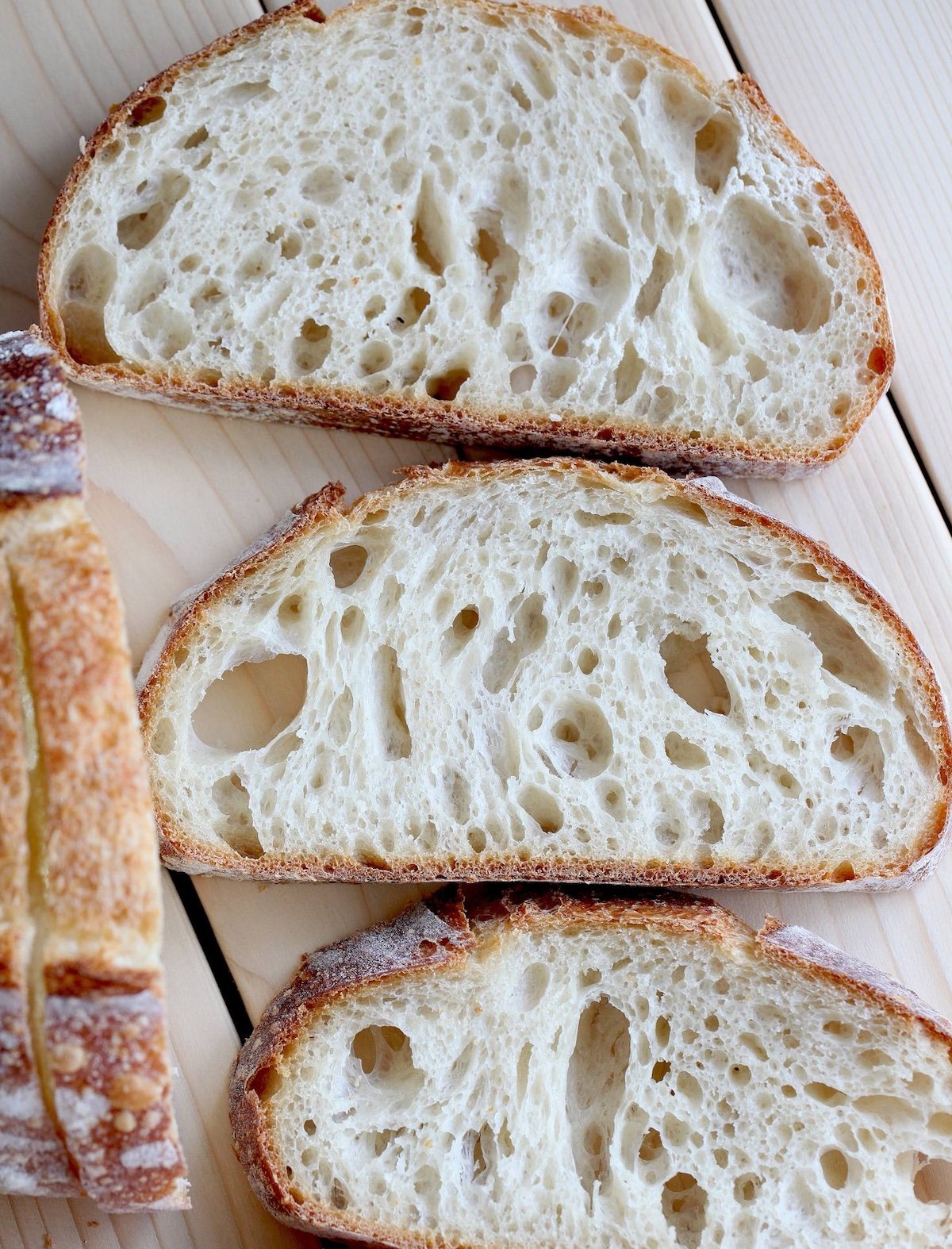
Would you like to save this?
Disclosure: Homestead and Chill is reader-supported. When you purchase through links on our site, we may earn an affiliate commission.
What Is Sourdough Starter?
Sourdough starter is a mixture of flour and water that also contains a stable colony of wild yeast and beneficial bacteria, and is nurtured by routine “feedings” to keep it alive and happy. It’s what makes bread rise without the need for commercial yeast.
If kept alive, one starter can last a lifetime of baking. And don’t worry! An established, mature sourdough starter is very easy to maintain with only infrequent feedings required (when stored in the fridge).
You can make a sourdough starter from scratch, get some from a friend who bakes sourdough, or buy one online. Since starting from scratch can sometimes be tricky, we offer organic dehydrated sourdough starter too. It’s quick, easy, and foolproof to use!
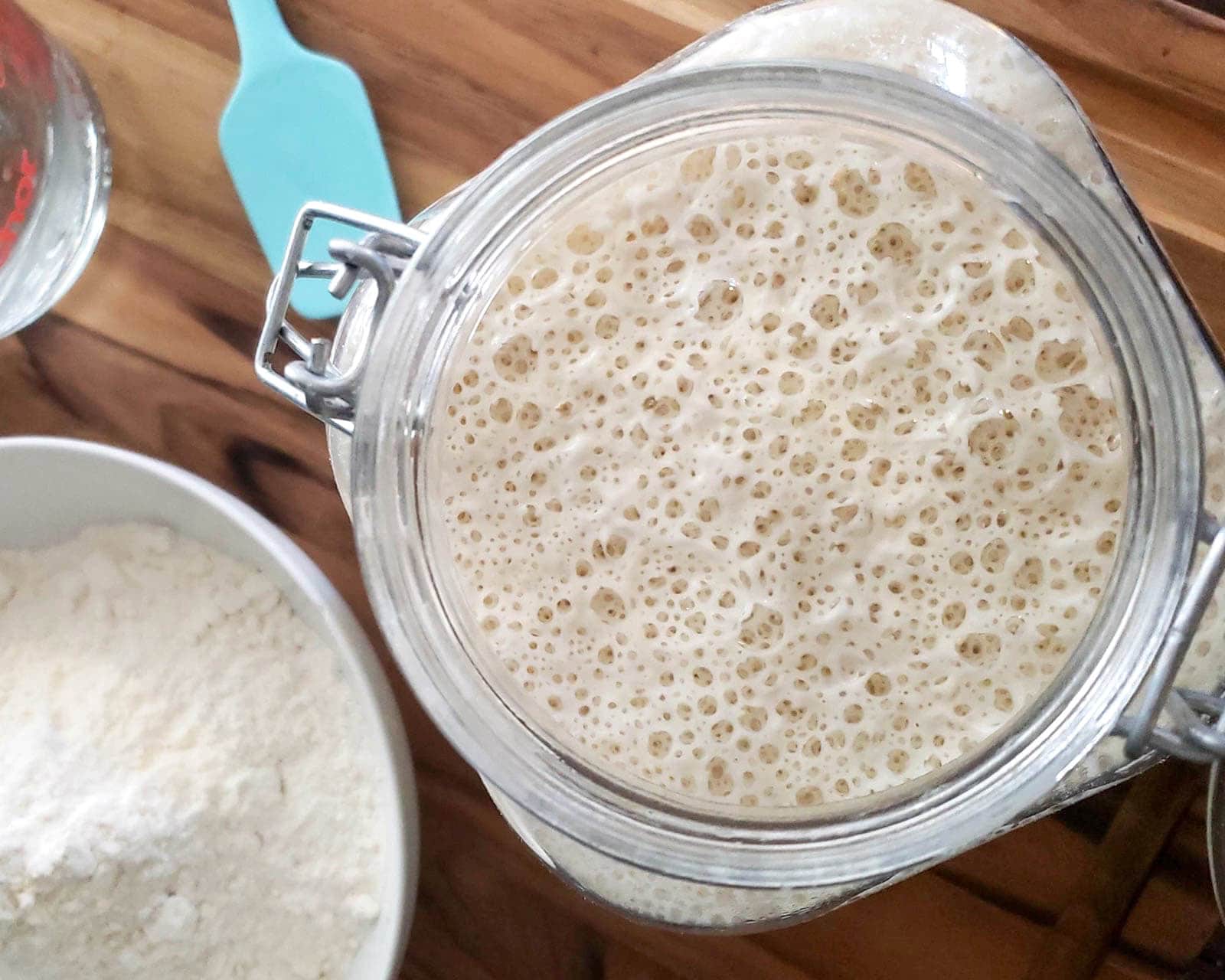
Supplies Needed
- A large, air-tight glass container. We used a 2-liter flip-top container, though a half-gallon mason jar works perfectly too.
- Organic white bread flour. You can also use organic whole wheat if you’d like.
- One large organic apple, or two small apples. See substitutions below.
- Filtered water
- A kitchen scale. Sourdough recipes are measured by weight instead of volume (cups) since different flours have varying densities or weights.
- A mixing bowl
- Liquid measuring cup
- A silicone spatula
- A cheese grater (for the apple)
- A moderately warm location
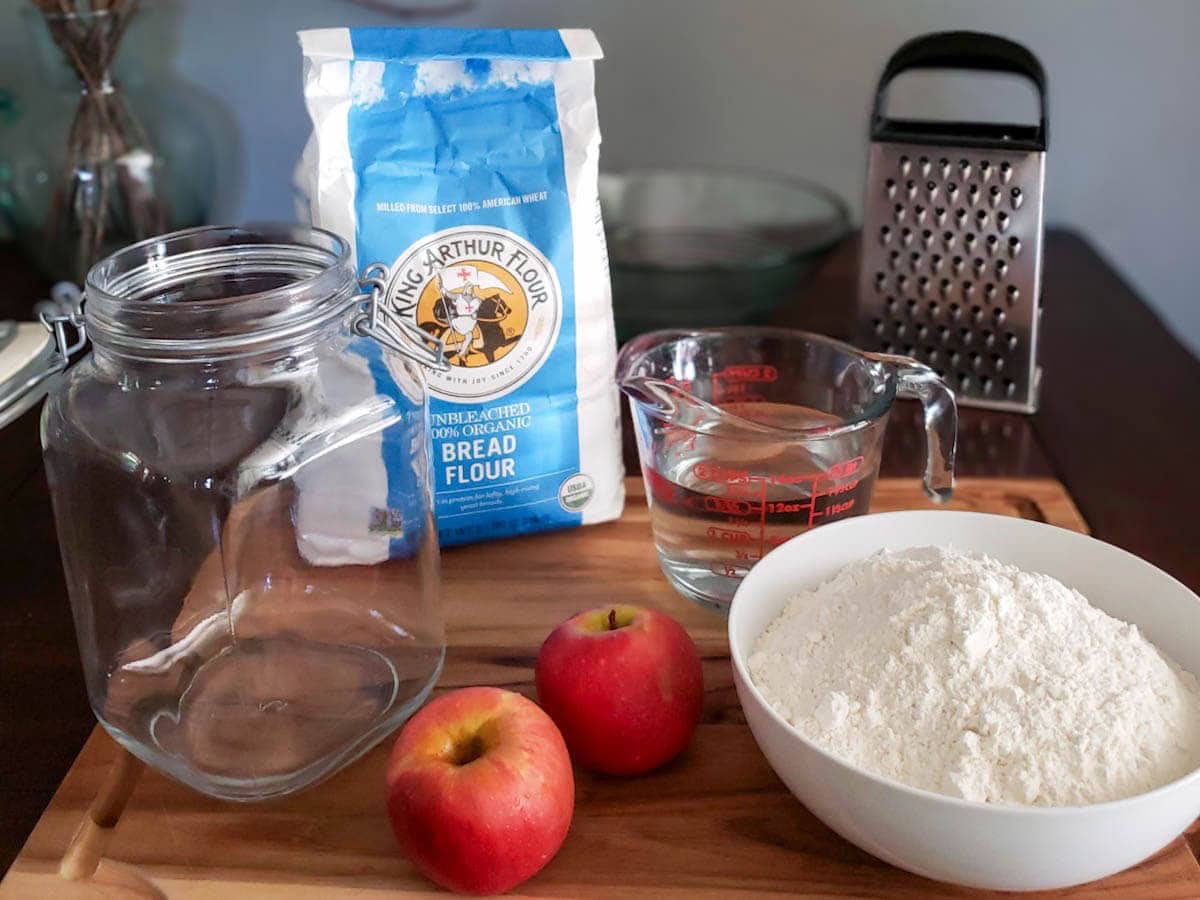
Why use apple to make sourdough starter?
Our homemade sourdough starter recipe includes apple to increase your chances of success! Flour and water alone are fairly sterile, but organic fruit and vegetables contain natural wild yeasts and beneficial bacteria on them, which helps to kick start the activity of your starter. The shredded apple completely dissolves into the starter and isn’t noticeable by day 5.
It’s key to use organic apples since non-organic produce has been treated with chemicals that can inhibit beneficial bacteria growth or contaminate your starter. If you happen to be allergic to apples, you can substitute with 1 cup of smashed organic blueberries or seedless grapes instead.
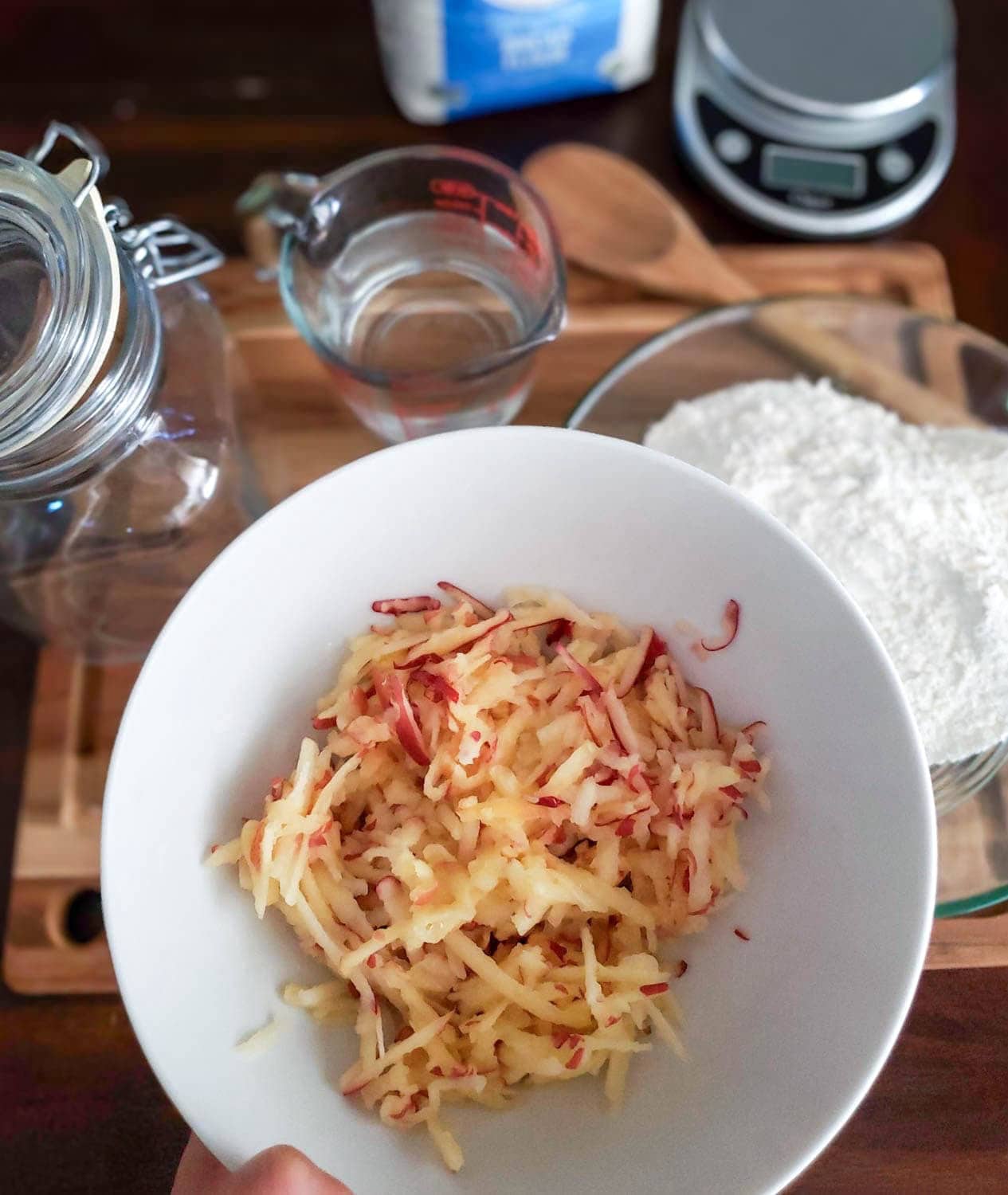
How to Make Sourdough Starter
Day 1: Mix
- In a large mixing bowl, weigh out 500 grams of organic white bread flour. Don’t forget to tare the bowl on the scale first, or add the weight of the bowl in to the total!
- Next, wash and grate the apple into fine shreds with a cheese grater. Use the peels but avoid the core, stem, and seeds. Add the apple to the bowl with the flour.
- Now add 360 mL of room temperature or warm filtered water to the bowl and mix thoroughly. It’s best to avoid chlorinated water when making sourdough if possible (but not distilled water) since chlorine can inhibit the growth of beneficial bacteria. The mixture will be quite thick and sticky at this point.
- Transfer the sourdough starter mixture into an air-tight container, pressed nicely into the bottom and with the lid closed. The container should have ample empty space to allow for the sourdough starter to at least double in size over the next few days, if not more.
- Finally, use a washable glass pen to mark the current level of the sourdough starter mixture in the container. (You could also use a large rubber band around the outside of the container.) This is to help monitor the rise!
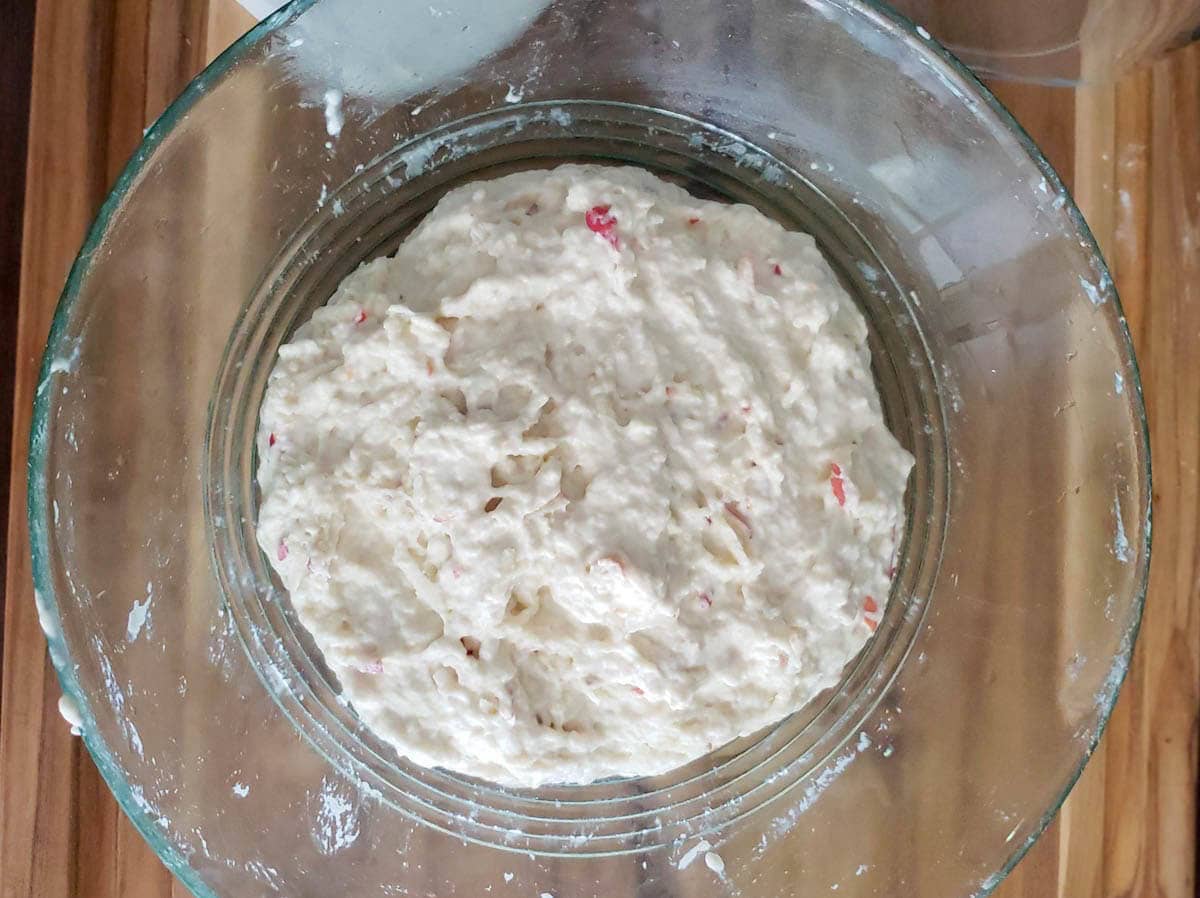
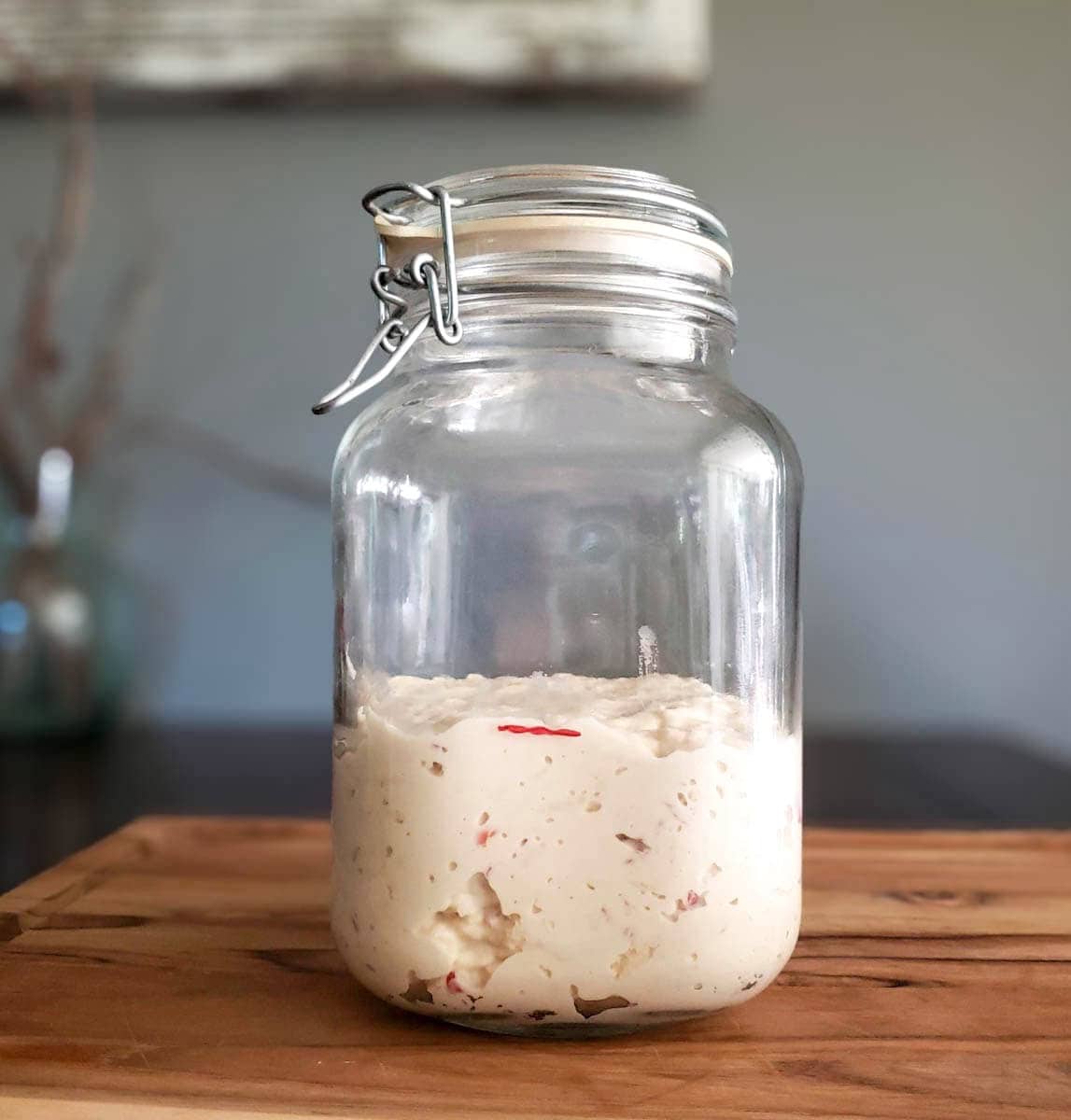
Day 2 and 3: Sit and Wait
- Now let the mixture sit for 3 days or about 72 hours after first starting.
- To make a new sourdough starter from scratch, it’s important to keep it in a location that is about 70 to 75 degrees Fahrenheit (23 degrees Celsius) to encourage beneficial bacteria activity. Cooler temperatures can easily lead to inactivity and mold growth. A dark or light location is fine, but keep it out of direct sunlight.
- If your home is cold, see tips and ideas on how to keep a sourdough starter warm below. Use a simple stick-on thermometer to easily monitor the temperature.
- During this time, the mixture may begin to form small bubbles and rise. In some cases, it may rise a lot! So you may want to keep the container on a plate to catch any overflow.
TIP: It’s possible for the sourdough starter to rise and then fall again before you notice (such as overnight) so look for smears on the sides of the container – not just the current level. However, it’s not essential to get a big rise at this stage!

Ways to keep sourdough starter warm:
- Find a warm spot in your house, such as next to or on top of a warm appliance. For example, our kitchen has under-cabinet lights that put off heat when they’re on, making the cabinets above quite warm and cozy. We’ve also placed it against a warm south-facing wall.
- Use a starter heating pad. Consider using a specialized heating pad to keep your sourdough starter warm, such as this wrap-around heat mat (thermometer included). It has precise temperature controls to keep the starter at the ideal temperature. My gardener friends use seedling heat mats too – just be sure it doesn’t get TOO hot! You may need to keep a towel or plate between the heat mat and starter jar.
- Oven light trick. Most oven light bulbs emit warmth, so turning on the oven light (but keeping the oven itself OFF) can create a nice warm spot in the back of the oven for your starter or proofing dough. However, I’ve heard horror stories when folks accidentally pre-heat or bake their starter! So if you try this, be sure to make a reminder that it’s in there – including for other members of the household.
- Proofing box. If you’re a regular baker with a chronically cool home, it may be worth investing in a proofing box – which can keep both your sourdough starter and proofing bread dough at the perfect temperature!

FAQ: What if my starter rises and falls before day 4? Can I move on to the next steps early? No, it’s best to wait. Sometimes, there is an initial burst of very vigorous activity on day 1-2, but that is usually caused by a different type of bacteria that quickly grows then dies off. Meanwhile, the main yeasts and bacteria (lactobacillus) that we want in the starter long-term grow a bit slower. So just be patient before proceeding to the next step!
Day 4: Discard and Feed
After 3 days or about 72 hours, it’s time to feed your sourdough starter for the first time! (This simply means adding fresh flour and water for it to “feed” on, so it can continue to get more active and strong.) By now, the mixture should smell sweet and tangy, sort of like apple cider vinegar. It may also be a bit darker in color.
- First, stir the mixture to knock out any air to let it fall back down to a more condensed state.
- Next, discard half of the amount in the container. This is to make more room in the jar for fresh flour, water, and to rise again! If you want to be exact, you can remove the mixture from its container, weigh it, and discard exactly half. Instead, I simply eyeball it by looking at the line marked on the jar.
- Now add 250 grams of of bread flour and 170 mL of lukewarm filtered water. Mix thoroughly. You can do this by either taking it all out of the jar, mixing it in a separate bowl, and then putting it back in – or simply mix everything right in the container itself.
- Clean up the sides of the jar a bit with a spatula so you can still monitor the rise and fall. (Also, gunky jar sides are more likely to mold.) Re-mark the level on your container if needed.
- Now, let your homemade sourdough starter sit for another 2 days or 48 hours in a warm location.
FAQ: What to do with the discard? Normally, you can use the discard from a mature sourdough starter in a variety of discard recipes like our fluffy sourdough pancakes, sourdough granola, or delicious sourdough discard crackers. However, the discard is still too young and won’t be a great addition to a recipe at this stage, so simply trash or compost it this time. Avoid putting it down your sink drain as it can cause clogs over time.
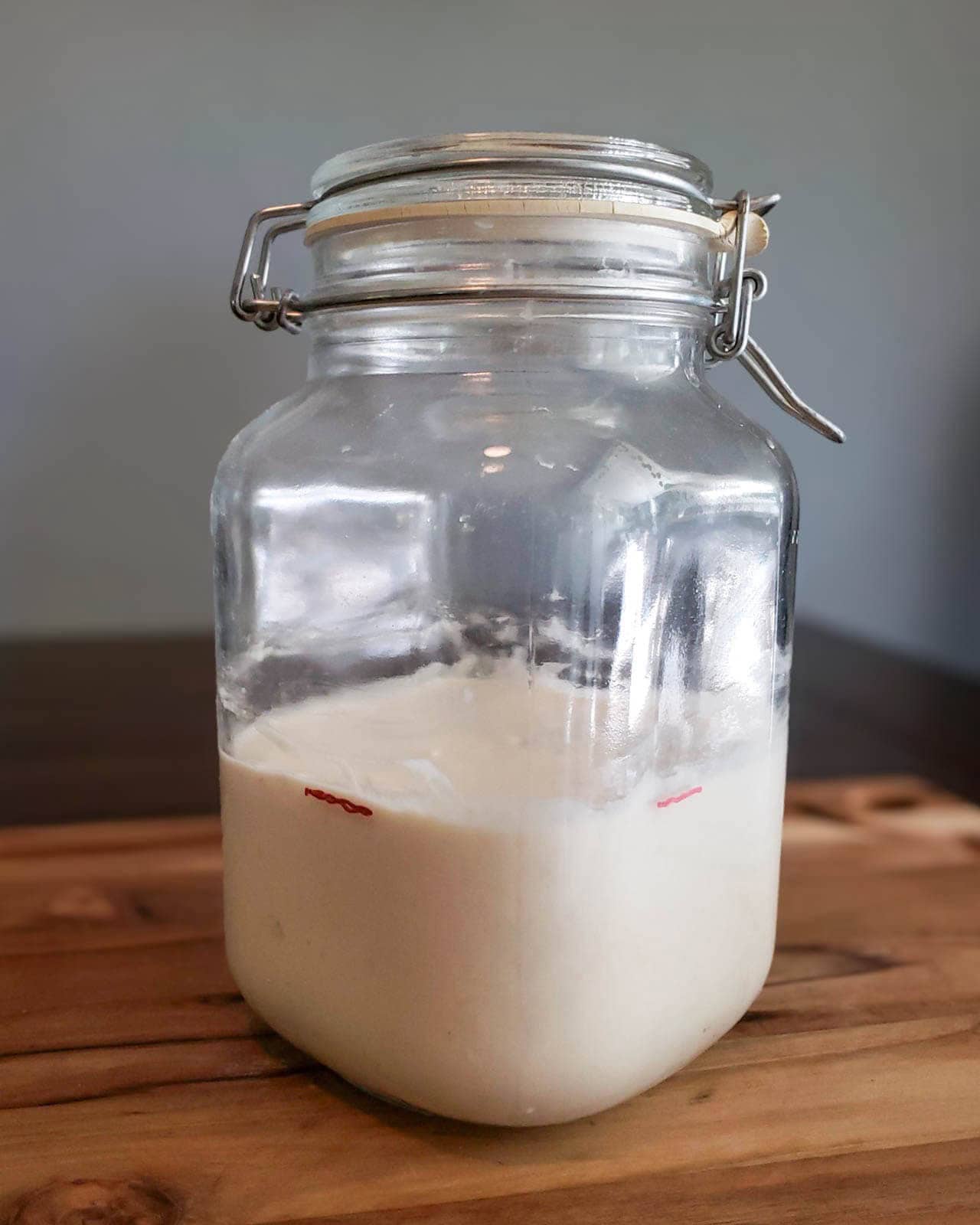
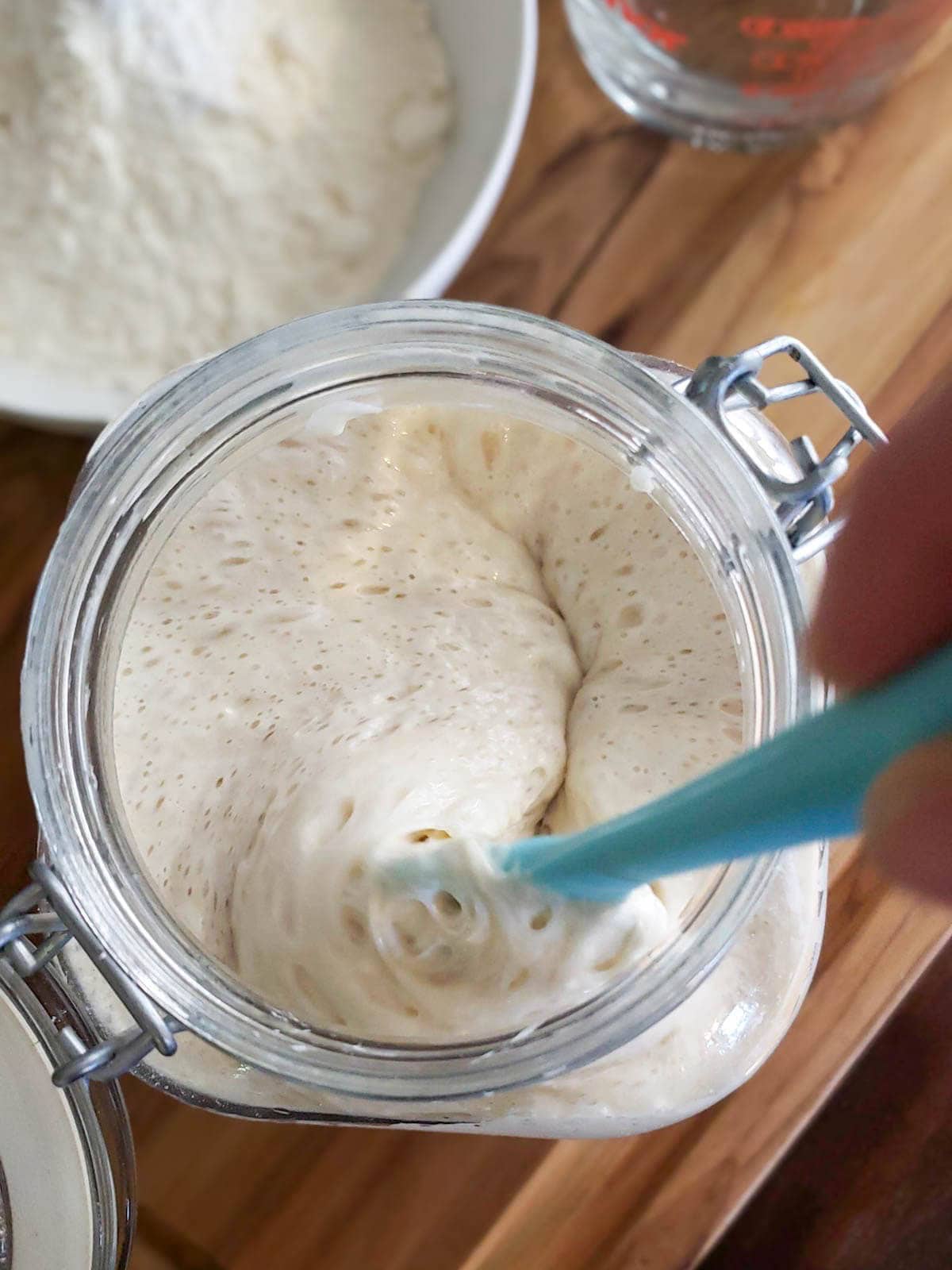
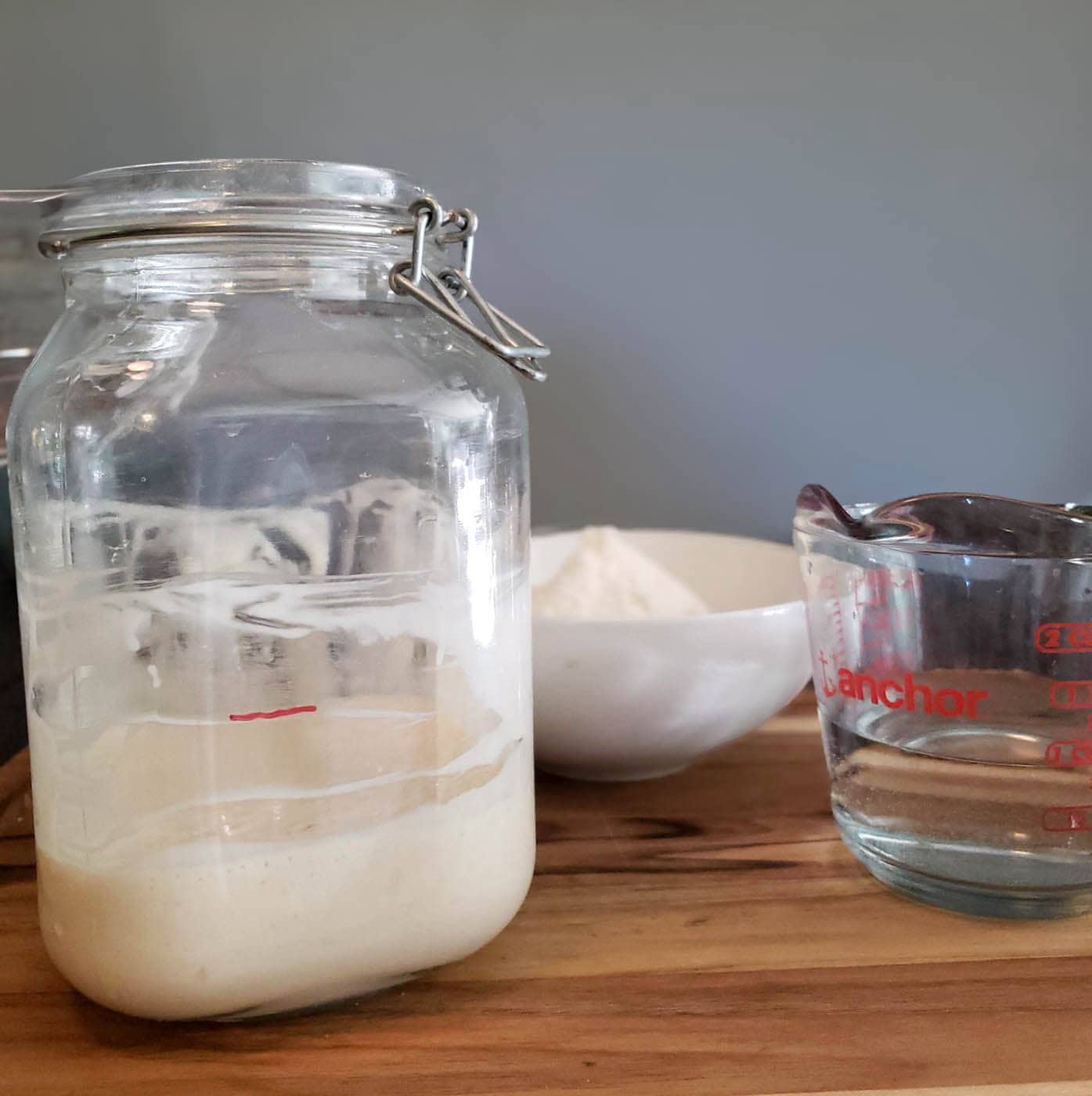

Day 5: Rest and Wait
Nothing to do today! Just let the new starter rest and rise. During this time, the colony of bacteria and yeast will happily feed on the fresh flour you provided, exponentially increasing their population as they do.
Day 6: Discard and Feed Again
Two days or about 48 hours after the first feeding, you should see a lot of activity and bubbles in your starter now! It also probably rose even higher than the first time. If so, it’s time to feed it again – just like you did on day 4.
However, if you’re not seeing much activity yet, let it sit for another day or two before discarding and feeding again. See more troubleshooting tips to increase activity below.
To feed, discard half the volume and then mix in another 250 grams flour and 170 mL of lukewarm water. It’s okay for the starter to be a tad more wet at this stage. It should be smooth and easy to stir, but not runny like pancake batter. If needed, add an extra splash of water (up to 30-40 mL more) until the desired consistency is reached.
Cover the sourdough starter and let it sit out one final time – for 24 hours this time.
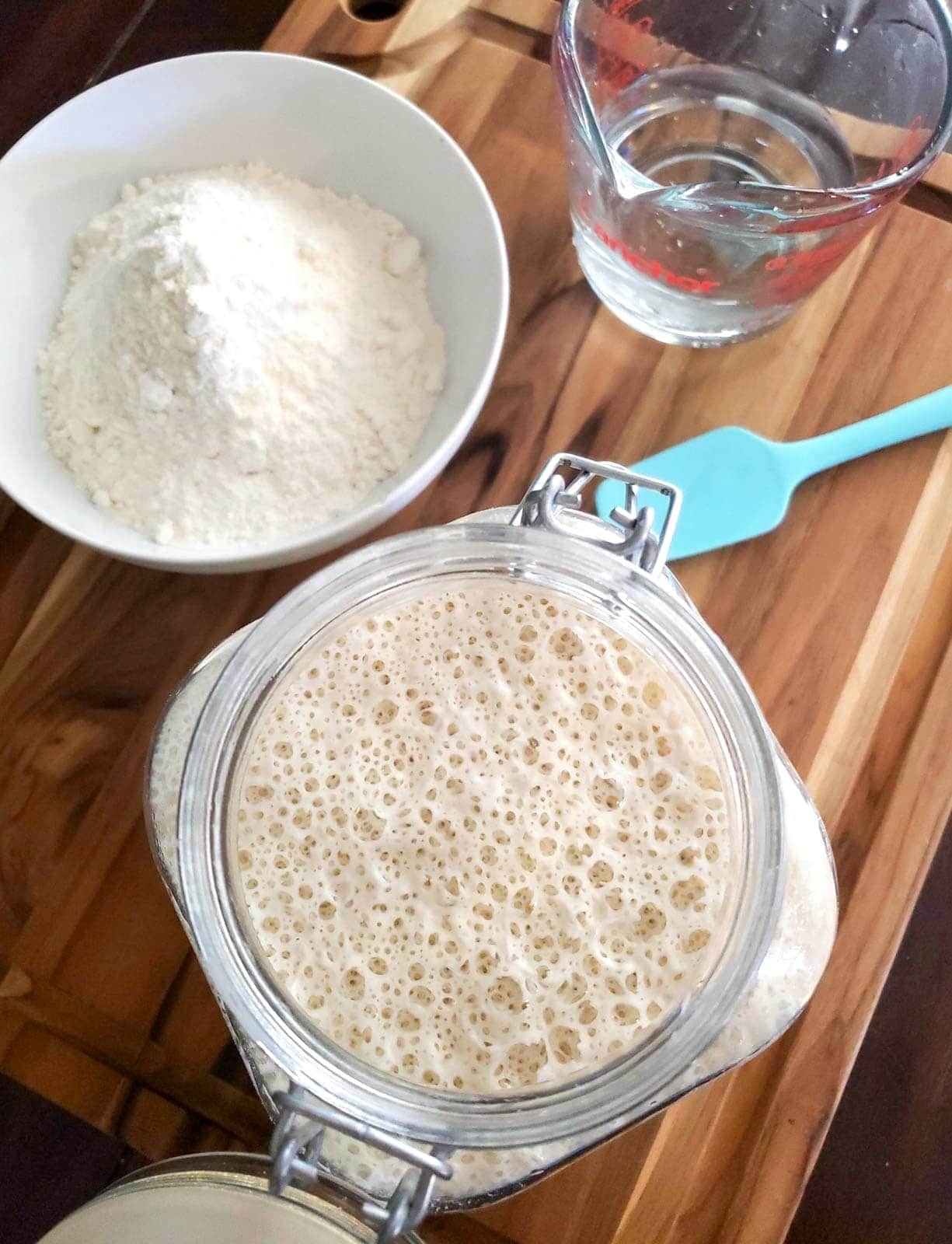
Troubleshooting
In most cases, a new sourdough starter should be bubbly and rising by day 6. However, if you are going to experience any issues, this seems to be the step where it may stall out.
- If there is no activity since the last feed, let it sit an additional day or two before feeding again.
- Is your home on the cool side? Try to find a warmer spot!
- If the starter has visible bubbles but doesn’t rise after feeding, the mixture may be too wet or runny (as varying home humidities and flour types can lead to different textures). When a starter is too wet, the bubbles rise right up and out of the mixture – rather than being trapped inside and causing the starter to puff up and become spongy. So, stir in more flour to thicken it up, adding just a few tablespoons at a time until it more closely resembles your original thick mixture from step 1 (a stiff dough).
- Another option is to try opening the lid of your jar. Cover it with a coffee filter or something else that will prevent fruit flies or other debris from getting inside.
- If your starter isn’t rising well and has a dark liquid formed on top, it may actually be overly active and hungry! Stir in a little more flour (and warm water as needed, if it becomes too thick and dry) and let it sit again. Wait a day or two to see if it perks up and begins to rise and bubble.
- Try to feed it with half whole wheat or rye flour, which usually enhances activity.
- If all else fails, it may be best to buy an established (dry) sourdough starter instead. Ours is foolproof to get going!
RELATED: Learn even more detailed troubleshooting tips in our guide on how to strengthen sourdough starter. Or, see this article on how to tell if a sourdough starter is bad.
Day 7: It’s Ready!
If it’s bubbly and active within 24 hours of the last feeding – congratulations – you just made a new sourdough starter from scratch! It’s now ready to bake with. (Keep reading below for tips on how to use and store it.)
But first, be sure to name your starter. It’s tradition among the sourdough community and considered bad baking luck if you don’t! Check out our round-up of the best 60 Punny Sourdough Starter Names for plenty of fun ideas.
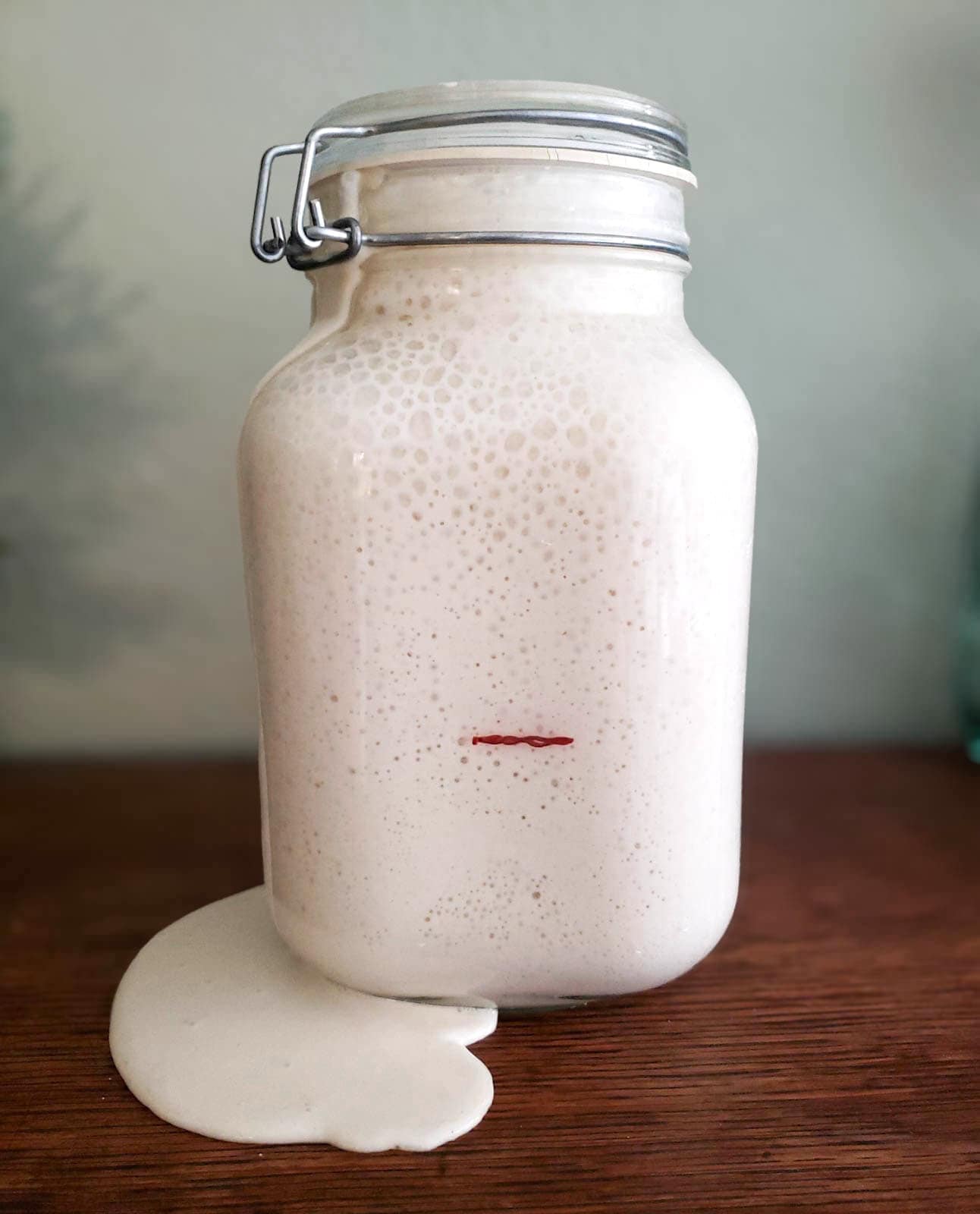
Next Steps: How to Use and Maintain Starter
Now what? If you aren’t ready to bake yet, simply store your starter in the refrigerator and then head over to our guide on how to maintain and feed sourdough starter. It covers the pros and cons of storing it at room temperature vs the refrigerator, when and how to feed it, and how to ready a starter for baking.
Hint: it’s best to use sourdough starter for baking several hours after feeding, once it’s reached “peak activity” – which is when it’s at least doubled in size, is no longer actively rising, but before it deflates again. And remember, never use ALL your starter in a recipe! Always save at least a half cup to feed and keep going.
To make bread, try our go-to no-knead sourdough bread recipe with step-by-step instructions and video. Our simple sourdough focaccia recipe is even easier! You can make all kinds of fun and delicious things like sourdough pumpkin bread, sourdough pie crust, sourdough cornbread and more! Explore all of our sourdough recipes and tutorials here.

FAQ: What’s that dark liquid on the top of my sourdough starter?
When a sourdough starter goes unfed for a while, it will form a layer of dark liquid on top called “hooch”. The yeast in starter produces hooch (an alcohol) as a natural byproduct of the fermentation process. Hooch is not harmful, but is an indication that your starter is hungry and needs to be fed.
When you see hooch, you can either pour it off the top or simply mix it back in, and then discard and feed as usual. However, mixing hooch into the starter will make it extra sour-tasting. Since we store our starter in the fridge and often go many weeks between baking/feeding, it almost always has a layer of hooch on top.
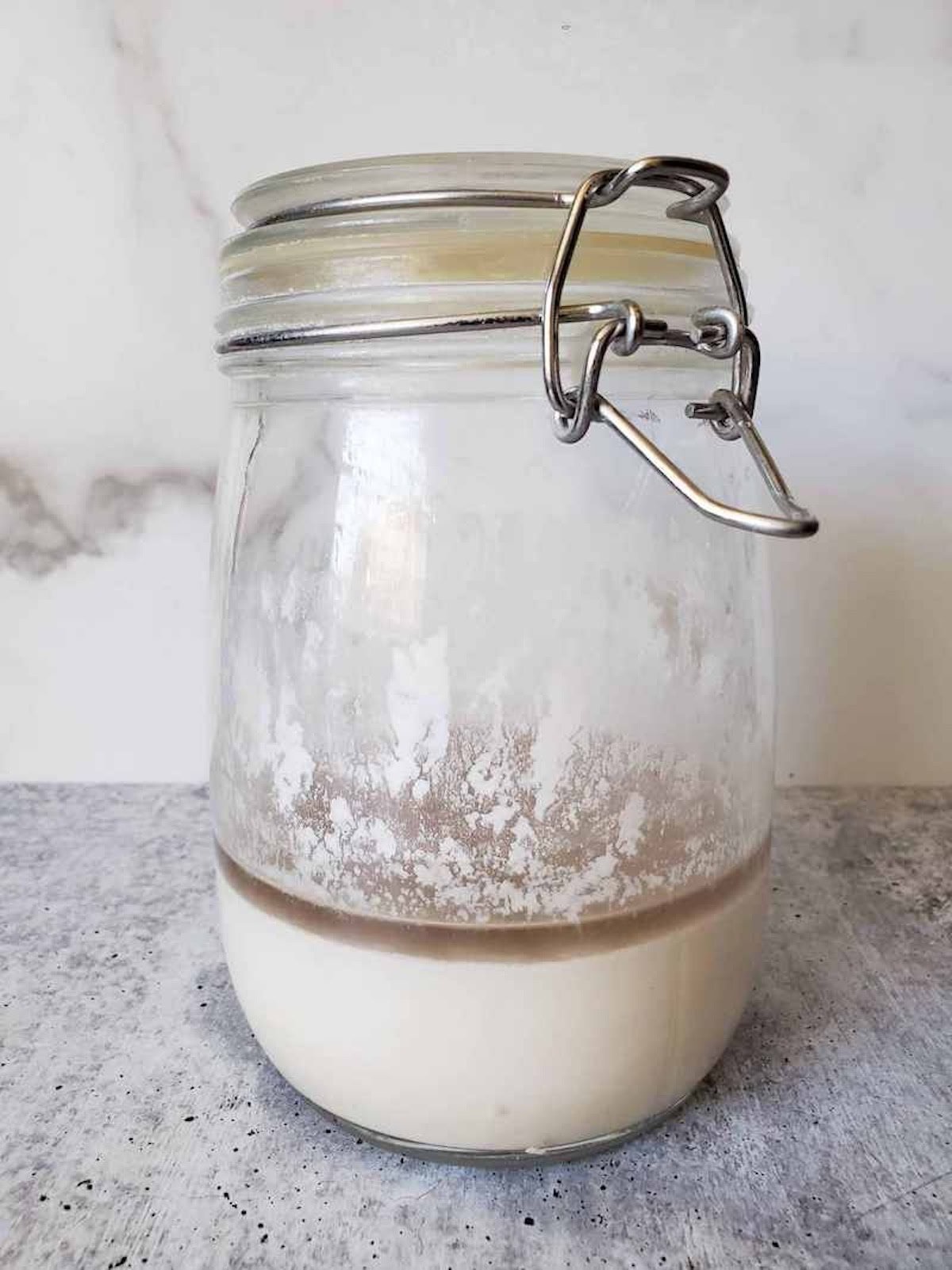
And that concludes this lesson on how to make sourdough starter from scratch. If you found this helpful, please leave a review in the printable recipe summary below! As always, feel free to ask questions in the comments below too. Have so much fun baking!
Video Tutorial

How to Make Sourdough Starter From Scratch
Equipment
- Large, glass, air-tight container (2 liter or half-gallon)
- Kitchen scale
- Mixing bowl
- Silicone spatula
Ingredients
- 500 grams organic bread flour or all-purpose flour
- 360 mL filtered water, room-temperature
- 1 large organic apple (or 2 small apples)
Instructions
- Wash your apple, but avoid using soaps or produce wash. Using a cheese grater, grate the organic apple into semi-fine shreds. Use the skins, but discard the core.

- Add the called-for flour, grated apple, and water to a mixing bowl and thoroughly combine.

- Transfer the mixture into a large glass airtight container that has enough room for it to at least double in size, minimum. (Ours usually quadruples while fermenting) Pack the mixture down into the bottom of the container. Close the lid.

- To monitor growth, mark the side of your container with a washable marker or rubber band at the top level of the mixture.
- Let the mixture sit for 3 days at a temperature of 70-75 degrees F. It should bubble and rise during this time.

- After approximately 72 hours, thoroughly stir the mixture and then discard half of the amount. Then, thoroughly mix in another 250 grams of flour and 170 mL of tepid filtered water to the remaining starter mixture. This is called "feeding" the sourdough starter. You can do this either in a separate bowl, and put it back into a now-clean ferment vessel, or like we do, mix it in place.

- Re-mark the container to note the height of the mixture. Let sit at 70-75 degrees, for 2 days or 48 hours this time.
- After 48 hours, repeat the same discard and feed process as done previously. Discard half, feed, mix, mark the level, and cover again.

- Allow the sourdough starter mixture to sit for a final 24 hours.
- Once complete, you now have a happy and active sourdough starter! Store it in the refrigerator when not in use, giving it a discard and feed weekly. OR if stored at room temperature, feed it daily to keep it alive.

Notes
- If there is no activity, let it sit another day or two.
- If your starter has risen and fallen, or, if seems to not rise after the first discard and feed, and instead it has a dark liquid formed on top (called hooch), it may actually be overly active and hungry! Stir in a little more flour (and warm water as needed, if it becomes too thick and dry) and let it sit again. Wait a day or two to see if it perks up and begins to rise and bubble.
- If your home is cold, try to find a warmer spot if possible!
- If the starter doesn’t rise at all after the first discard and feed, try opening the lid of your jar. Cover it with a coffee filter or something else that will prevent fruit flies or other debris from getting inside inside.
- Another troubleshooting tip is to feed with half whole wheat or rye flour, which usually enhances activity.
- Ensure that you use an organic apple.





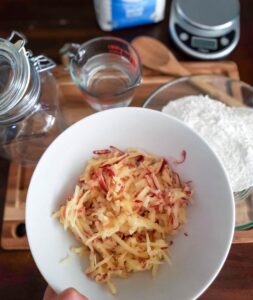
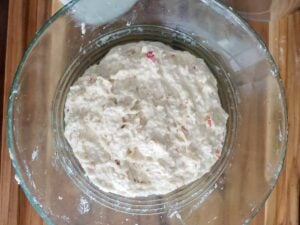
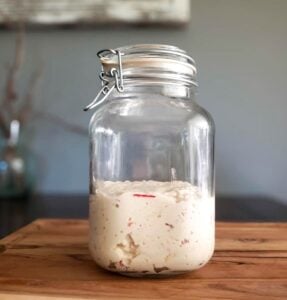
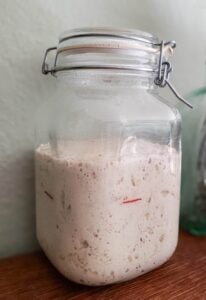
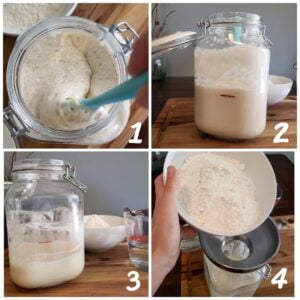
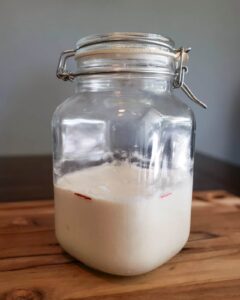
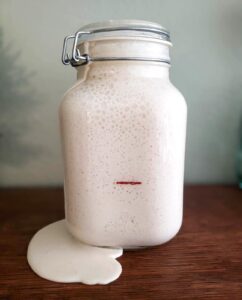



303 Comments
Lisa
I tried several different, well-recommended Sourdough Starter recipes, since August, and while most of them performed as you describe in the initial stages, not ONE of them ever passed the float test—-but were bubbly, smelled great, had good consistency—-and the loaves failed to rise, looked like deflated footballs, etc., a very disappointing effort all the way. I don’t know if having a small kitchen, 3 dogs (one Giant breed and two “normal” sized), or some other unknown factor killed these starters, but I kinda gave up. I just baked a standard, French bread style yeast bread and it looks fabulous, no issues at all. Any ideas why my starters failed to yield? I’m willing to try your method…..fingers crossed.
Thanks!
Aaron (Mr. DeannaCat)
Hello Lisa, I am not sure why your experience using your own sourdough starter hasn’t worked out too well. We have only had good results and if anything we hear some people have a hard time making their own starter from scratch, we have another article that may be helpful that pertains to How to Feed Your Sourdough Starter + Storage & Care Tips. We also sell dehydrated sourdough starter that can be reactivated in a fairly fool proof manner found here. Hope that helps and let us know if you have any other questions.
Sherice Potter
Hi Aaron and Deanna~
I just made the starter today! I’m so excited for sourdough everything!! It’s my all time fave bread and I’ve always wanted to try it but never have until I found your IG last week and hopped over here to your blog and I’m SMITTEN!!!
I your place looks like heaven! It must be so rewarding to sit back and enjoy your splendor with a nice cup of joe in the morning or with a tiny mixie (aka titos and san Pel w/lime) in the evening! I’ve also printed off your garden planning tool kit and it’s AWEMAZING!!!!!
I can tell how much love went into it!! I’m excited to learn your ways and have my own lush thriving nirvana of my own come spring/summer!!
Blessings comin atcha ~
Emily
Hi Deanna,
Thanks for sharing this recipe! This is a bit of a silly question, but after the starter has been established, should we continue to feed it the 250grams of flour + 170mL of water as outlined in this article? I noticed in your post on how to maintain a starter that you suggested weighing out equal amounts of starter, water and flour (e.g. 100g of each) and am now a bit confused!
Thanks for your help,
Emily
Aaron (Mr. DeannaCat)
Hello Emily, once the starter is established you should switch to How to Feed Your Sourdough Starter + Storage & Care Tips. Feeding equal amounts weight of starter, flour, and water is the suggested practice. However, we usually just “eyeball” it now and feed what we need for our baking needs which is usually a scant cup flour and 1/2 cup water. This gives us enough starter to use for one loaf of bread with enough to reserve for future use. Hope that helps.
Dee
Hi Deanna
Thank you so much for your great recipe and instructions, for the first time ever I seem to be having some success with a starter!! Just wondering however what do as my starter has already tripled in size just 24 hours after commencing. The starter bubbled out and down the side of my jar last night and this morning it has shrunk again down to about double the size of day 1. Just wondering if I just leave it alone until the 72 hours is up or should I feed it again now that it has started shrinking? Thanks so much for your help. Dee 🙂
DeannaCat
Hi Dee! I would wait a little longer, but not necessarily the whole 72 hours… maybe until it falls back to almost about the starting point. Good luck!
Anna
Hello! This recipe is AWESOME! I’ve been trying for months to make a starter from just flour and water with no luck! With the apple, it became instantly active 🙂 However, we hd a random cold night last night and it got down to 65 in our kitchen…I keep the starter right next to the fridge. It was on day 2 and getting super bubbly and rising quite a bit, but this morning it looks like its starting to fall, there’s little smears. I’ve wrapped it in a towel to keep it warm and the temperature is rising again, I’m just wondering if the cold may have zapped all the yeast and bacteria and I should start over, or will it become active again and continue to rise? Thanks for your assistance and I appreciate you!
DeannaCat
Hi Anna – As long as it doesn’t get moldy, I think it will be fine! Continue on with the process – that is the only way to see! Best of luck, and thanks for being here!
Anna
Awesome! Thanks! I will! It still looks active, lots of bubbles. Curious about a pinkish hue on the top of the starter… My apple had pinkish skin…? If it’s mold, it’s really obvious right? Thanks!
Lisa Greenberg
Hi, after 2 days, my starter more than doubled, but it smells, not a good smell. Is that ok? Also, I didn’t have a jar big enough, so I put it in 2 jars. Will that affect anything when I want to use it?
Aaron (Mr. DeannaCat)
A sourdough starter should not smell bad, it may have some strong yeasty with slight alcohol aromas coming from it but I am not sure of what exact smells are coming from yours. If you have two jars, you will have two starters. You want a jar that will allow the material to at least double in size after you feed it, this is especially true once your starter is established. We have found a 32 ounce jar to be the minimum size suggested for an established sourdough starter which usually provides enough starter for one loaf of bread with some remaining to start the process over. Hope that helps and good luck!
Debbie
First of thank you, thank you for everything. Your knowledge is a gift to us all. You are a tremendous inspiration.
Is it possible to make the starter without the apple? Thanks
Gaby
Hi Deanna! Thank you for all of the wonderful information. I am currently working on my first sourdough starter baby as we speak! Out of curiosity, can I use the first discard (discard taken out after the first 72 hour period) for other baking projects? Or is it better to wait until the starter has stabilized and matured? Thanks!
DeannaCat
Hi Gaby, you can experiment with using the first discard (it won’t do any harm) though I would personally wait and use it once it is fully mature and active. Early on in the stage, the beneficial bacteria and yeast are still being established and there may still be some apple bits or flavor that are still present.
Kathi Johnson
After the starter has matured can you give it away as starter for someone else to feed and take care of or a second starter for me if I need to make several things?
DeannaCat
Hi Kathi – Yes, absolutely! The “discarded” portion during feeding can easily go into another container, be fed, and become a new starter for someone!
Brittani
I absolutely loved working on this recipe! My first starter didn’t go as planned and I wound up tossing it after a few days of inactivity. I think it was a combo of my using the incorrect flour (non-organic, non-bread flour as flour is still scare around here!) and we had a cold snap right around when I was starting so a steady temperature wasn’t Easy to maintain for my poor starter.
However, my second try with organic spelt flour went amazingly well! I actually have TOO MUCH starter and am gifting half of my girl Phyllis (that’s what we named our starter) to my mom! I even went right in to making The Homestead and Chill’s sourdough loaf and it came out so beautifully I want to cry (we Love bread here!) I am so excited to finally have an active starter and hope to keep it happy for years to come ❤️
Dee
Hi Brittani, sounds like we have walked a similar sourdough starter journey 😉 After several unsuccessful starts I am finally having some success with Homestead and Chill starter (so exciting). I was thrilled to read you got it to work with spelt as I would love to try that too but was wondering if you also changed the flours in the bread loaf recipe to include spelt? Thanks so much for your advice and also to Deeana for the awesome instructions and advice!!!
Dee 🙂
Martha
My started has been rising like crazy; first 24hrs, doubled. Now it doesn’t fit in its container. Can I discard while I’m within the first 72hrs? If I discard, do I have to re-feed or can I leave as is?
DeannaCat
Hi Martha – Try to wait to do the discard and feed until it has risen and then fallen back down on its own, signaling that it is hungry and ready for the next step. If needed, slightly crack the lid and let it overflow over the sides (set it on a plate). The next round isn’t usually quite as active… but if you started in too small of a container, you may want to move it to a larger one at the time of the first discard/feed. Best of luck!
Sarah
I was honestly more impressed with myself for getting/keeping my starter alive than I am for keeping my tiny human alive! This was a bit of work, but ooooh how worth it! Deanna’s guidance is comprehensive, and incredibly helpful. She answers questions here that you wouldn’t even know that you would have. I love that. I definitely recommend reading all the way through before you start… it can alleviate some growing pains you may encounter. Thank you, Deanna! This was a fun process and I was able to make the most delicious loaf of bread!
Tera
Curious. What happens with the grated apple during this process? Does it settle to the bottom so you can discard it easily?
Aaron (Mr. DeannaCat)
Hi Tera, the apple actually is eaten and dissolves into the starter leaving no trace of it even being in there. Thanks for reading and good luck!